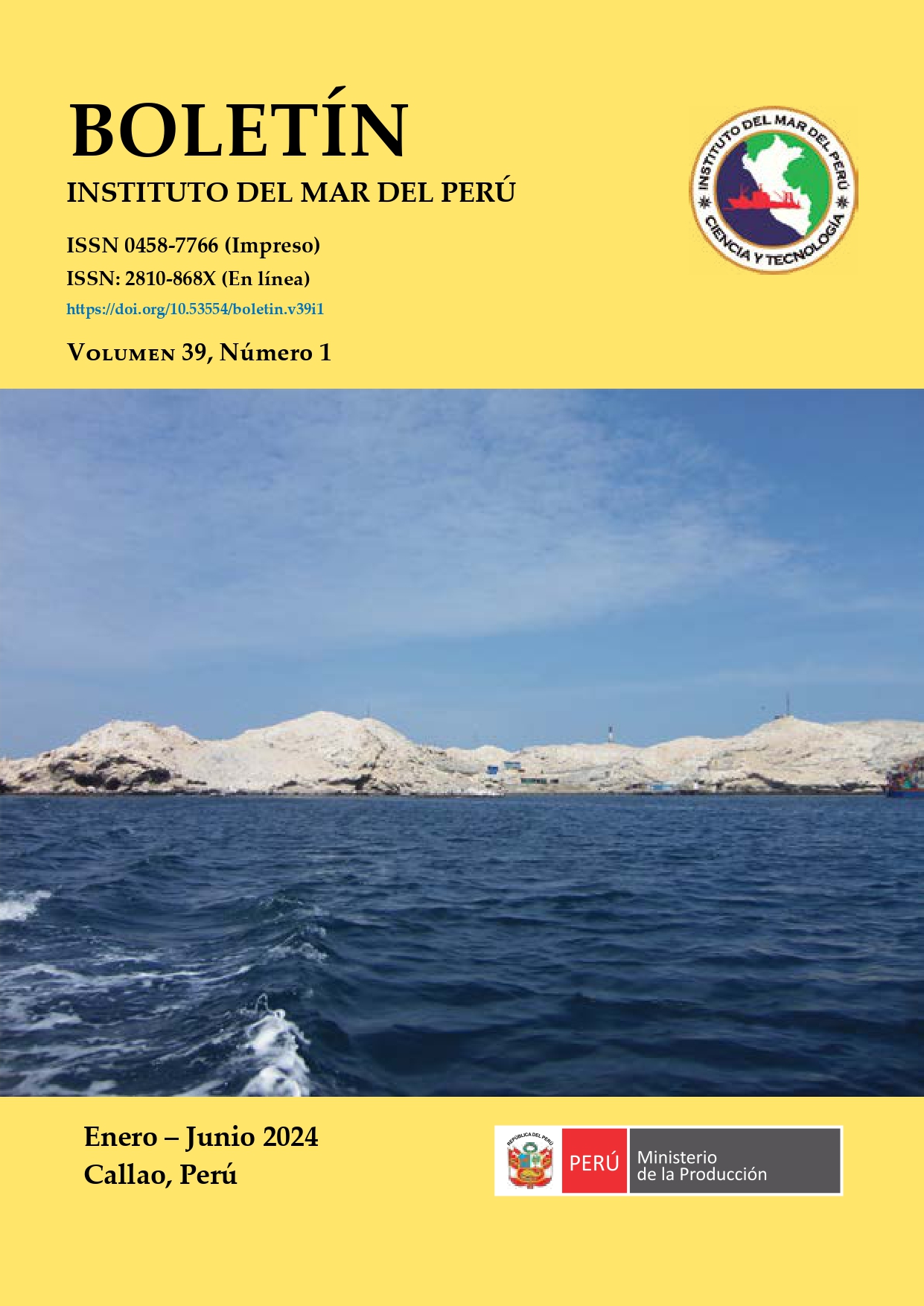First report of harmful algal bloom caused by the dinoflagellate Heterocapsa sp. along the shores of Camaná, 2023
DOI:
https://doi.org/10.53554/boletin.v39i1.411Keywords:
Heterocapasa, Harmful algal bloom, Camaná, Arequipa, PeruAbstract
During the first fortnight of February 2023, in the province of Camaná-Arequipa, the first occurrence of harmful algal bloom caused by the dinoflagellate Heterocapsa sp. was documented. This microalga produces surfactant substances on the sea surface. When the organism disintegrates, it releases a toxin carried by waves and winds to the shore, causing irritation to the skin, respiratory system, and eyes of beachgoers. The average cell density reached 18.27 x 105 cells. L-1. In the initial two days of the algal bloom, the average oceanographic parameters recorded were: sea surface temperature 20.4 °C, salinity
34.705, dissolved oxygen 3.40 mL/L, and pH 7.80. The proliferation of harmful algal bloom was attributed to an upsurge in radiation, variable winds, and an augmented inflow of continental water laden with nutrients.
Downloads
Alternative Metrics
Metrics
References
Aké-Castillo, J. A., Rodríguez-Gómez, C. F., PeralesValdivia, H. & Sanay-González, R. (2016). Florecimiento de Heterocapsa rotundata (Dinophyta) en el estuario río Jamapa, Veracruz. En E. García-Mendoza, S. I. Quijano-Scheggia, A. Olivos-Ortiz & E. J. NúñezVázquez (Eds.), Florecimientos algales nocivos en México (pp. 322-333). CICESE. https://www.cicese.edu.mx
Andersen, P. (1996). Design and implementation of some harmful algal monitoring systems (IOC Technical Series No. 44). Unesco & Conseil international pour l’exploration de la mer.
Anderson, D. M., Glibert, P. M. & Burkholder, J. M. (2002). Harmful algal blooms and eutrophication: Nutrient sources, composition and consequences. Estuaries, 25(4b), 704-726. https://doi.org/10.1007/BF02804901
Carrit, D. E. & Carpenter, J. (1966). Comparison and evaluation of currently employed modification of the Winkler method for determining dissolved oxygen in sea water. J. Mar. Res., 24, 286-318.
Diaz, R. J. & Rosenberg, R. (2008). Spreading dead zones and consequences for marine ecosystems. Science, 321(5891), 926-929. https://doi.org/10.1126/science.115640
Escobar, J. (2002). La contaminación de los ríos y sus efectos en las áreas costeras y el mar (Serie recursos naturales e infraestructura 50). CEPAL. https://repositorio.cepal.org/items/457595f8-9384-4046-92c7-afbab7f351f6
Hallegraeff, G. M., Anderson, D. M., Belin, C., Dechraoui-Bottein, M. Y., Bresnan, E., Chinain, M., Enevoldsen, H., Iwataki, M., Karlson, B., McKenzie, C. H., Sunesen, I., Pitcher, G. C., Provoost, P., Richardson, A., Schweibold, L., Tester, P. A., Trainer, V. L., Yñiguez, A. T. & Zingone, A. (2021). Perceived global increase in algal blooms is attributable to intensified monitoring and emerging bloom impacts. Communications Earth & Environment, 2(1), 117. https://doi.org/10.1038/s43247-021-00178-8
Moreira-Gonzalez, A. R. (2010). Dinoflagellate blooms in eutrophic zones of Bahía de Cienfuegos, Cuba. Harmful Algae News, 41, 10-11. https://www.researchgate.net/publication/292963476_Dinoflagellates_blooms_in_eutrophic_zones_of_Cienfuegos_Bay_Cuba
Oda, T., Sato, Y., Miyasaki, Y., Muramatsu, T., Matsuyama, Y. & Honjo, T. (2004). Hemolytic toxin of the dinoflagellate Heterocapsa circularisquama as a possible causative factor responsible for shellfish kill. Harmful Algae. 195-197.
Paerl, H. W. (1982). Factors Limiting Productivity of Freshwater Ecosystems. In K. C. Marshall (Eds.), Advances in Microbial Ecology (pp. 75-110, Vol. 6). Springer. https://doi.org/10.1007/978-1-4615-8318-9_3
Paerl, H. W. & Huisman, J. (2009). Climate change: a catalyst for global expansion of harmful cyanobacterial blooms. Environmental Microbiology Reports, 1(1), 27-37. https://doi.org/10.1111/j.1758-2229.2008.00004.x
Sánchez, S. & Delgado, E. (1996). Mareas rojas en el área del Callao (12°S) 1980-1995. Inf Prog Inst Mar Perú, 44, 19–37. https://hdl.handle.net/20.500.12958/1231
Sánchez, S., Delgado, E., Bernales, A., Jacobo, N., Franco, A. & Correa, D. (2021). Floraciones algales nocivas en la costa peruana durante El Niño Costero 2017 y su relación con las condiciones ambientales. Bol Inst Mar Perú. 36(2), 452-462. https://doi.org/10.53554/boletin.v36i2.347
Smith, V. H. (2021). The challenges of understanding and predicting cyanobacterial blooms. Freshwater Science, 40(2), 307-323.
Utermöhl, H. (1958). Zur Vervollkomnung der Quantitativen Phytoplancton methodic. Mitt. Int. Ver. Limnol., 9,1-38. https://doi.org/10.1080/05384680.1958.11904091
Wang, S., Wang, W. & Jiang, X. (2012). The Process of algal bloom formation and the effects of wind - an enclosure experiment and in situ investigation in a large hyper-eutrophic shallow lake in China. Advanced Materials Research, 518-523, 4303-4314. https://doi.org/10.4028/www.scientific.net/AMR.518-523.4303
Wu, X., Liu, Y., Weng, Y., Li, L. & Lin, S. (2022). Isolation, identification and toxicity of three strains of Heterocapsa (Dinophyceae) in a harmful event in Fujian, China. Harmful Algae, 120, 102355. https://doi.org/10.1016/j.hal.2022.102355
Xu, L., Yang, D., Greenwood, J., Feng, X., Gao, G., Qi, J., Cui, X. & Yin, B. (2020). Riverine and oceanic nutrients govern different algal bloom domain near the Changjiang Estuary in summer. Journal of Geophysical Research: Biogeosciences, 125(10), e2020JG005727. https://doi.org/10.1029/2020JG005727
Downloads
Published
How to Cite
Issue
Section
License
Copyright (c) 2024 Boletin Instituto del Mar del Perú

This work is licensed under a Creative Commons Attribution-NonCommercial-ShareAlike 4.0 International License.









